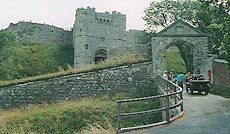 Island History
Island History
Location | Travel Information | History | Geography | Geology | Towns and Villages
Island Art | Beach Guide | National Trust
The Isle of Wight's history is what story books are made of. From the Romans onwards, many, including the Danes, French and Spanish came to plunder and pillage, and a few succeeded. In the year AD 43 the Roman writer Suetonius recorded that 'the island of Vectis, very near to Britannia, has been reduced to subjection.'
In 686 Christianity was introduced by the West Saxon King Caedwala. In 1066 'William the Conqueror' conquered! As a result the Isle of Wight contains a rich store of ancient churches, castles and fortifications. After centuries of vulnerability, Carisbrooke Castle, the Island's main defence, was built by a relative of William the Conqueror.
 Carisbrooke Castle
Carisbrooke Castle
During the English Civil War King Charles the First fled to the Island after escaping from Hampton Court Palace. He was promptly imprisoned at Carisbrooke, from where he was returned to London for execution. He was beheaded in 1649.
Centuries later, Queen Victoria has a happier association and took advantage of the coming of the railways to use Osborne House at East Cowes for her retreat. The house was enhanced for visiting heads of state as the Queen spent more of her later years on the Island. It was at Osborne House that she died on 22 January 1901.
During World War Two the Island was heavily defended and made a restricted area. In 1940, the fall of France and occupation of the English Channel Islands opened up the real possibility of an invasion of Britain, and the Isle of Wight was historically a beachhead. Throughout the war the Medina River was jammed with destroyers and warships under construction and repair. PLUTO, the PipeLine Under The Ocean, crossed the Island where fuel was stored ready for the D-day forces on the Normandy beaches. At Arreton, the venerable St George's Church carries a memorial window to the Burma Star Association.
Thatched villages still nestle in the folds of the hills. Ancient churches, Elizabethan manors and working mills vie for pride of place. The magic remains.